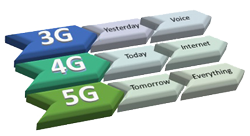|
Ericsson and NTT DOCOMO announced that in a joint
fifth-generation (5G) technologies trial, the companies achieved a cumulative
20 Gb/s of data throughput in an outdoor environment, using the 15-GHz
frequency band with two simultaneously connected mobile devices of a downlink
bitrate of more than 10 Gb/s each. In a separate trial, the companies also
achieved data throughput that exceeded 10 Gbps at a distance of approximately
70 m from the base station. Moreover, the tests reached data transmissions exceeding
9 Gbps at a distance of approximately 120 m from the base station. The trials
used Ericsson 5G radio prototypes with multiple user, multiple-input,
multiple-output (MU-MIMO) and massive MIMO to increase downlink throughput.
Ericsson 5G radio prototypes use MU-MIMO to transmit data to several user
devices using the same time and frequency resources, thus increasing the
system’s spectral efficiency. Massive MIMO—the combination of MIMO and
beamforming with a large number of antenna elements— improves both throughput
and energy efficiency. With beam tracking, Ericsson 5G radio prototypes track
the position and movements of a given device and point one or more beams in the
best direction for that device in real time, to ensure consistently reliable
connections.  These beams can originate from multiple transmission points. Each
compact 5G radio prototype, the size of a piece of carry-on luggage, supports
the equivalent of 40 long-term evolution (LTE) carriers. These beams can originate from multiple transmission points. Each
compact 5G radio prototype, the size of a piece of carry-on luggage, supports
the equivalent of 40 long-term evolution (LTE) carriers.
ZTE Corporation and China Mobile officially announced their
latest 5G high-frequency prototype and demonstrated a 10-Gb/s+-high bitrate, beam
tracking, and other key 5G technologies. The ZTE-developed prototype operates
on a 15-GHz carrier with a bandwidth of 500 MB, and boasts a hardware structure
of a large-capacity baseband unit and an intelligent remote radio unit (RRU). Its
high-frequency, ultrawide band, and compact design optimize performance and
provide a MU-MIMO peak bitrate as high as 10 Gb/s+. This unit also uses
beamforming technology. The networks division of Samsung Electronics America
concluded a series of successful mobile, fixed wireless, and in-building
penetration 5G wireless tests delivering multi-Gb/s speeds at Verizon
headquarters. The tests including live streaming of 360° virtual reality (VR)
content using Samsung Gear VR. Using Verizon’s FiOS wired network and Samsung’s
5G Hybrid Adaptive Array antenna radio technologies, Samsung delivered 5G
wireless speeds over a millimeter wave (mmWave) band spectrum. During the
trials, Samsung also exhibited 4K ultrahigh-definition video content
transmission over the air while in a moving vehicle using automatic beamforming
MIMO.
Huawei and Deutsche Telekom (DT) showed what they claim to
be the world’s first 5G end-to-end (E2E) network slicing demo at the Mobile World
Congress. The joint demo aimed to validate network slicing technology, which
can create, with high flexibility and efficiency, network slice on demand in
each given application scenario. The 5G E2E network slicing implementation based
on Huawei’s service-oriented architecture has been driven to enable E2E network
slicing through basic core network (CN) modularization and control plane/user
plane separation. The CN and radio access network (RAN) interface is specified and
implemented to support real E2E network slicing. For slice lifecycle management
and slice monitoring, a slice manager for both the RAN and CN has been
produced.
Full article: IEEE Vehicular Technology Magazine, Volume 11, Number 2 (June 2016) |